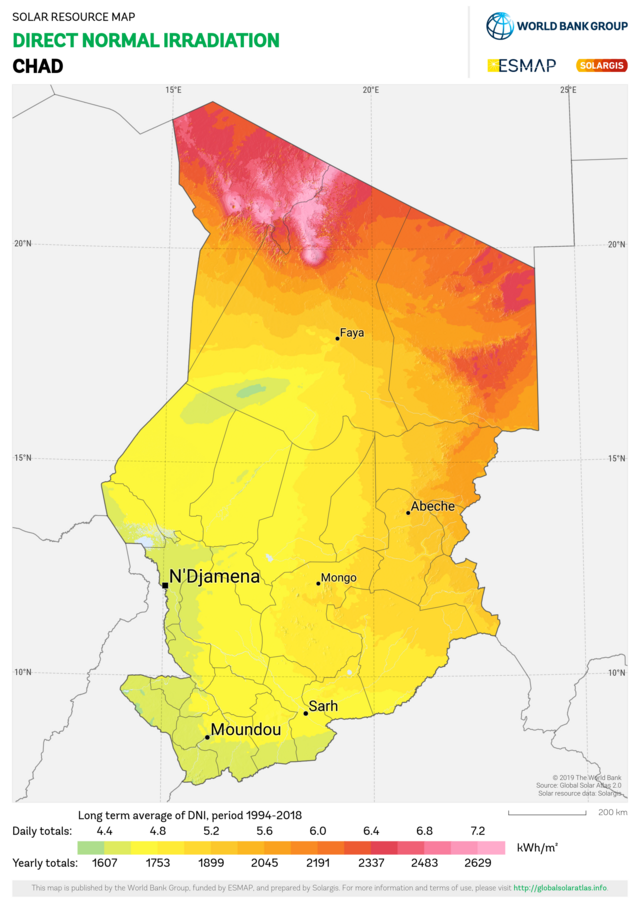By Fatimé Mahamat Ngarayo
BITKINE, CHAD — As twilight descends over the central Chadian town of Bitkine, a warm glow spills from a solar-powered streetlamp, illuminating a bustling corner where children kick a deflated football, vendors sell fried dough, and young women chat outside their homes. Just a few years ago, this scene would have unfolded in near-total darkness.
In one of Africa’s least electrified nations—where nearly 90% of the population lives without reliable access to electricity—a quiet revolution is underway. Across Chad, communities once plunged into nightly blackouts are discovering a new kind of independence: solar-powered energy.
“We used to rely on candles or kerosene lamps. They were expensive—and dangerous,” says Hinda Alifa, a mother of five in the southern town of Koumra. “Now, our children can study at night. We feel safer.”
From schools to clinics, and from homes to micro-enterprises, Chad’s investment in solar energy is delivering more than just light—it’s unlocking opportunity.
A Shift Toward the Sun
While Chad is rich in sunlight, for decades it lacked the infrastructure and policy framework to harness its potential. That’s changing fast.
In 2022, the Chadian Ministry of Petroleum and Energy partnered with the International Renewable Energy Agency (IRENA) to design a national strategy aimed at scaling up off-grid solar access. With support from international donors and development banks, solar microgrids and household systems are being deployed across rural regions—where over 75% of the population resides.
The centerpiece of this effort is the Solar for Development Program, backed by the World Bank and the African Development Bank. The program aims to electrify 1,000 rural health centers, 500 schools, and provide power to 300,000 households by 2026.
Energy for Health and Learning
In the remote village of Goz Beida, a once-faltering health post now runs refrigerators to store vaccines, fans to cool patients, and solar-powered diagnostic equipment—all thanks to a modest rooftop array.
“We can now perform minor surgeries and deliver babies safely at night,” says Dr. Abakar Ousmane, a nurse practitioner. “It’s a game-changer.”
Similarly, the Lighting Africa initiative, led by the International Finance Corporation (IFC), has helped deliver solar-powered lanterns and phone-charging kits to students in rural areas. Teachers report marked improvements in attendance and performance.
“Before, I had to stop teaching when the sun went down,” says Lydie Doumara, a teacher in the Guéra region. “Now, our night classes are full.”
Private Innovation, Public Impact
Entrepreneurs are also stepping into the light. In N’Djamena, TechSol Tchad, a solar startup run by university graduates, installs home systems that power lights, fans, and small appliances for under $100.
“There’s real demand—and a new kind of pride,” says founder Brahim Laoukein. “People don’t want to wait for the grid. They want energy now.”
The government has offered tax incentives for renewable energy imports, while NGOs like Power Africa are helping to build the skills and financing pathways for local solar technicians.
Greener Grids for a Hotter Climate
Chad’s energy transition is also about resilience. The country ranks among the most climate-vulnerable nations in the world, with desertification and droughts threatening agriculture and livelihoods.
By investing in decentralized solar, Chad is building adaptive infrastructure that requires no fossil fuels and resists seasonal disruption. Projects like the Sahel Alliance’s Renewable Energy Access Initiative are helping Chad pursue its nationally determined contributions under the Paris Agreement (https://www.alliance-sahel.org/en/achievements/energy-access/).
“Renewable energy isn’t a luxury here—it’s survival,” says Hadje Amina Mahamat, a senior advisor at the Ministry of Environment.
A Future Illuminated
The road ahead remains long. High costs, limited financing for small developers, and a shortage of skilled technicians still slow progress. But for many Chadians, the flicker of solar light has already brightened their daily lives.
In the village of Bébédjia, a solar kiosk offers cold drinks, mobile banking, and internet access. At night, it becomes a meeting point for teens to gather and dream.
“I want to become an engineer,” says 14-year-old Souleymane, eyes wide as he points to the solar panels overhead. “I want to build light for other villages too.”
What began as a necessity is now becoming ambition. From flickering candles to clean energy futures, Chad’s solar-powered journey is not just about electricity—it’s about empowerment.
Sources:


